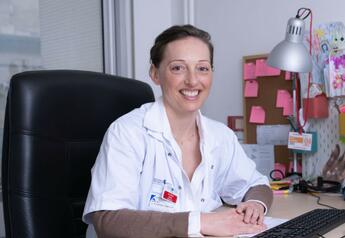
Endometriosis: treatment is possible
On the occasion of European Endometriosis Prevention and Information Week, and two years after the launch of the national strategy to combat endometriosis in France, Dr Kamila Kolanska takes stock of this pathology, which affects almost one in ten menstruating women.

Dr Kamila Kolanska is an obstetrician-gynecologist and head of the Medical Assistance for Procreation (MAP) unit at Tenon Hospital, as well as a researcher at the Saint-Antoine research center and a member of the Sorbonne University endometriosis expert center.
What is endometriosis?
Kamila Kolanska: Endometriosis is characterized by the development of endometrial cells outside the uterus. They can migrate and form nodules in various parts of the pelvic region (such as the peritoneum, ovaries, fallopian tubes, ligaments), the digestive tract or, more rarely, in other parts of the body, such as the pleura.
These cells react to hormones in the same way as the endometrium of the uterus, shedding during menstruation. Bleeding from these nodules, leading to inflammation and scar tissue formation, causes abdominal pain and sometimes difficulties in becoming pregnant.
How does this pathology affect the daily lives of women who suffer from it?
K. K.: Endometriosis is not a serious disease, except in rare cases when it affects the digestive or urinary systems, with occasional kidney complications. On the other hand, it does have an impact on the daily lives and quality of life of women who suffer from it, and who have to cope with pain that can sometimes be incapacitating. Some highly symptomatic women can't even get out of bed during their periods. Fortunately, these cases do not represent the majority of women with endometriosis.
Until a few years ago, the problem was largely unknown. Menstrual pain was often under-diagnosed as a normal part of menstruation. Today, however, treatment is possible. So it's important that women who suffer from it are referred to specialists to assess the need for appropriate treatment.
How can these patients be treated?
K. K.: There are several approaches to help patients live well with endometriosis and combat the symptoms. These range from pain management, to infertility management, to surgery.
In terms of pain management, options range from simple anti-inflammatory prescriptions to hormonal treatments such as continuous pills and, in exceptional cases, artificial menopause. Paramedicine also plays a role, with approaches such as osteopathy, psychology, acupuncture, physiotherapy, sophrology and nutrition. Indeed, a healthy diet can help reduce inflammation.
Not all forms of endometriosis require surgical intervention. However, in certain cases where lesions are extensive, particularly in the digestive tract, surgical treatment may be considered. It is preferable that such surgeries, which are often cumbersome and carry the risk of complications, be carried out in referral centers.
LEndometriosis is also often associated with fertility problems, isn't it?
K. K.: The mechanism explaining the link between endometriosis lesions and infertility is still poorly understood, but among affected women, around one in two will experience fertility problems, compared with one in 10 in the general population.
This also means that half of all women retain normal fertility, whatever the specific lesions of endometriosis. Some may have extensive lesions and conceive easily, while others, with minor lesions discovered incidentally, may experience fertility problems.
You are in charge of an MPA unit. What treatment options are available to maximize the chances of conception in cases of endometriosis?
K. K.: For women with endometriosis who wish to become pregnant, we intervene to shorten the time to spontaneous conception from the general recommendation of waiting one year to six months.
Studies show that in vitro fertilization (IVF) is preferable to insemination for endometriosis. Whereas insemination offers a 15-20% chance of pregnancy, IVF offers a 40% probability, provided a good-quality embryo is available. Although patients with endometriosis sometimes require more intensive treatment because they respond less well or have slightly more difficulty in obtaining good-quality embryos, the chances of pregnancy are comparable to those of women without endometriosis, once the embryo has been obtained. The question of surgery may also arise after several IVF failures to reduce inflammation.
It is important not to delay pregnancy plans, because unfortunately, MPA is not infallible. Whatever the etiology of infertility, age remains an aggravating factor, as the ovarian reserve gradually diminishes. Between the ages of 35 and 38, this decline accelerates, and from the age of 38 onwards, there is a significant decline. If a woman is considering medical fertility preservation, it is therefore advisable to do so before the age of 35.
In certain cases of highly symptomatic and extensive endometriosis associated with infertility, initial surgical management may be considered, depending on the woman's age and the overall infertility assessment.
You are a member of Sorbonne University's endometriosis expert center. Can you tell us about its role in the fight against endometriosis?
K. K.: This structure offers the possibility of comprehensive endometriosis care within a single department. Radiologists specialized in ultrasound and MRI are dedicated to diagnosis. They work in close collaboration with the center's surgeons and gynecologists, some of whom have dual training in gynecological and digestive surgery. Urologists are also on hand to deal with urinary disorders. Surgeons are trained to intervene and remove endometriosis lesions, while preserving fertility as much as possible. Specialists in the endocrinology and reproductive medicine unit help guide women in their choice of hormone treatments. The reproductive medicine department provides assistance in cases of infertility. Specialized anaesthetists also help with pain management.
Weekly meetings bring together the entire team to discuss complex situations. This interdisciplinary collaboration enables us to deal with difficulties at all levels.
The center also has a research activity. What does it focus on?
K. K.: We are involved in clinical research protocols, and the publication of works concerning fertility preservation, endometriosis surgery, understanding the causes of this pathology.
In the field of MPA, our efforts are mainly focused on clinical studies, particularly with regard to pain perception. We are also working on the link with other pathologies to better understand the relationship between infertility and endometriosis.
We are also conducting translational studies. Researchers at the center recently evaluated the diagnostic efficacy and clinical utility of the Endotest® salivary test for complex endometriosis diagnostic situations. This test could be an alternative to more invasive diagnostic methods, and could help reduce the time it takes to diagnose endometriosis, which currently averages 7 years.
